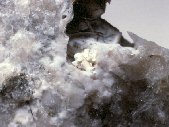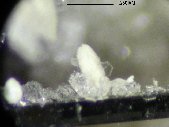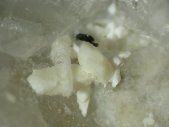Thumbnails

Griceite crystals
© Reproduced courtesy of Canadian
Museum of Nature
Ottawa, Canada

Griceite crystals
© Reproduced courtesy of Canadian
Museum of Nature
Ottawa, Canada

Griceite crystals
© Bill Lechner
LiF
Griceite was first described from Mont Saint-Hilaire and is the first known natural occurrence of lithium fluoride. It is a late stage mineral occasionally lining and filling cavities in sodalite xenoliths.
PHYSICAL CHARACTERISTICS:
Color varies from pure white to pale yellow to very pale greenish yellow.
Luster is porcelaneous to waxy to dull.
Diaphaneity is transparent when fresh, rapidly becoming translucent
to opaque.
Crystal System is isometric; Fm
Crystal Habits include compact powdery to bortyroidal masses
lining and filling cavities, masses of tiny cubes stacked to form
prismatic aggregates 2-3mm long, and as tiny plates and blobs
embedded in villiaumite.
Cleavage: {001} is good.
Fracture is uneven to conchoidal.
Hardness is 4.5
Specific Gravity is approximately 2.6g/cm
Streak is white.
Associated Minerals include eudialyte, lovozerite, sodalite,
ussingite, villiaumite and vuonnemite.
Distinguishing Features: Pale yellow fluorescence under SW.
Origin: Named in 1989 for Joel D. Grice (1946-), curator of minerals,
Canadian Museum of Nature, Ottawa, Canada.
CLASSIFICATION:
Dana System
# 9.1.1.5
Strunz Classification
# III/A.02-05
REFERENCES:
CanMin 27:125-127 (1989), MinRec 21:313 (1990), Dana 8:376 (1997)
DISTRIBUTION AND RARITY AT MONT SAINT-HILAIRE:
MSH
¤¤¤

Griceite crystals
© Doug Merson

Griceite crystals
1,5 mm
© Gilles Haineault
